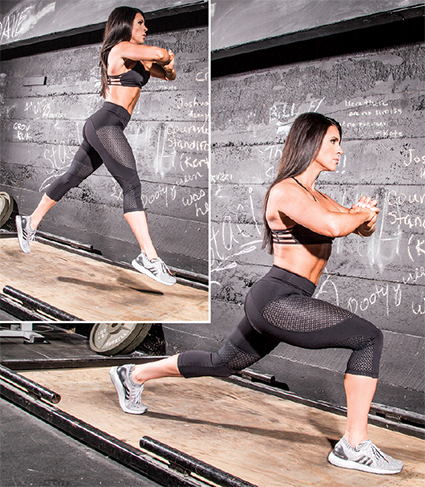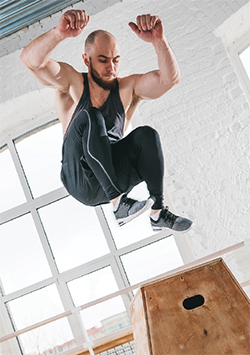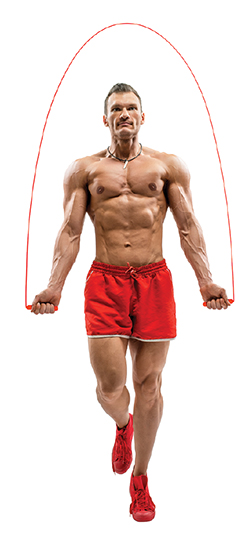BURN MORE BLUBBER WITH OUR CIRCUIT BLITZ!

BURN MORE BLUBBER WITH OUR CIRCUIT BLITZ!
Melt the fat in less time with these science-backed, Muscle Insider-approved circuit-training programs
In today’s hectic world it seems like most people suffer from the dreaded time crunch. Not everybody has 60 to 90 minutes to spend at the gym. We don’t all have one to three minutes to wait between sets, or time to walk around the gym aimlessly from leg machine to leg machine, debating what to do next. Circuit training takes the waiting out of it; you move quickly and efficiently … and burn fat faster!
In our time-crunched society, it can be tough to find time to hit the gym—never mind making the time to do both strength training and cardio. Forty-hour workweeks, class schedules, children’s extracurricular events, and general adult responsibilities all add up quickly and can leave you feeling exhausted by the end of the day. But, you still want to do something for your health, and walking back and forth to the water cooler in your office isn’t cutting it. If you’re looking for a way to get a great workout into your day efficiently, circuit training might be the answer you’re looking for.

What the Science Says
The health benefits of exercise are well-known, and to reap these benefits, a complete training plan should include both cardiovascular and strengthening activities. Cardio training plays a role in weight control and heart health and can help lower blood pressure, while resistance training is effective for improving your basal metabolic rate, bone density, and muscle growth. It sounds great, right? So, how much of these activities do you need to do for your health?
Let the Burning Begin
With nearly half our population falling into the overweight and/or obese categories of the body mass index scale, the majority of exercisers head to the gym on a mission to lose weight. If fat loss is your goal, your training sessions should definitely include both strength and cardio work. Strength training will burn calories while you’re putting in the work, and will continue long after you leave the gym. Additionally, building more muscle mass will bump up your metabolism, helping you burn more calories throughout the day in general. Add in some cardio work to further increase that burn and you’re speeding up your fat loss. So, what happens if you combine these two modalities into one killer workout? Fat annihilation.
The Basics of Circuit Training
Circuits combine strength training with cardiovascular work, giving you an exhausting full-body workout in a short time frame—perfect for anyone with a tight schedule looking to shed some pounds, build some lean muscle mass, or generally improve his or her fitness level. Circuits involve various exercises that you perform back to back. Once you’ve completed all the exercises in one round of the circuit, take a short recovery break before starting the circuit again. Moving quickly between exercises keeps your heart rate high, giving you a cardio workout even if you don’t perform “typical” cardio activities.
The possibilities are endless with circuit training, based on the space and equipment available to you. A tough workout can be achieved in a hotel room with a resistance band, at your neighbourhood park, or in a gym with full equipment, making circuits a great training tool for everyone.
Benefits Bonanza
The intense bursts of cardio will burn more calories than your typical cardio session, and in less time. Because the sessions are shorter, you can work at an intensity level greater than you would if you were aiming to run for 45 to 60 minutes straight. A challenging circuit can be completed in less than 30 minutes, and that includes a warm-up and cool-down period. An added bonus of circuit training is that you can customize it to suit your needs. Only have 15 minutes to work out? Reduce the number of exercises you include and keep your rests shorter.
The key factor to circuit training is the rest period. By keeping rests short—basically aiming to recover enough to go all-out again—you can increase your post-exercise oxygen consumption for greater metabolic impacts. In fact, it has been found that men who rest for 20 seconds between circuits burn more calories than men who rest for 60 seconds. However, the same study found that those who rested longer burned more calories overall (during exercise plus one hour post-exercise), likely because they were able to put more effort into the circuit following the longer recovery time. If fat loss is your goal, aim to burn the most calories overall, even if that means taking slightly longer recovery periods in order to push yourself as hard as possible during the work phases. If you’re looking to improve your overall fitness from an endurance standpoint, keep rest periods short to challenge your cardiovascular system.
The health benefits of circuit training don’t stop with fat loss. A study using sedentary, obese men examined the impact of high-intensity circuits on various biochemical and physical outcomes. The men performed three 30-minute circuits per week over the four-week study and showed significant improvements in their resting heart rate, systolic blood pressure, fat tissue percentage, lean muscle tissue percentage, cholesterol, and insulin levels.
 A Word of Caution
A Word of Caution
As with all forms of exercise, there are potential risks to consider before trying something new, and circuits are no different. Because of the intense nature of circuits, they may not be the best form of exercise for everyone. Individuals who haven’t been active on a regular basis, are overweight or obese, or are recovering from an injury should gradually work up to performing a circuit at full intensity. Additionally, it’s recommended that those with hypertension or heart disease avoid quick transitions from intense aerobic exercises to isometric exercises (e.g., planks or wall sits) because of the impact it has on heart rate and blood flow. If you’re unsure of a particular movement in a circuit, ask a professional before attempting it, or swap that exercise out for something you’re comfortable with.
Remember, just as with any workout, you get out what you put in. Keep the weight as heavy as you can while maintaining proper form, push the cardio boosts as hard as you can, and move quickly between exercises to get the most out of these sessions. Keeping your rest under a minute will help keep your heart rate elevated and your mind focused on the task. When you’re ready to sweat, give these circuits a try.
How to Make It Your Own
One of the best attributes of circuit training is its flexibility. If you’re working around an injury, pick exercises you can do without pain. If you dislike a certain cardio exercise because you aren’t coordinated enough for it, swap it for something more basic such as high knee runs. Nothing is set in stone; you have the freedom to customize your workout based on your skill, fitness level, time constraints, and available equipment.
Additionally, you can alter the pattern of movements. These circuits alternated strength exercises with cardio bursts in between (e.g., squats, jumping lunges, walking lunges with weight, jump squats), but you could create a circuit consisting of solely strength-training exercises. If you’re looking for a quick cardio session, cut out the strength exercises altogether and use different bursts of cardio.
Making small changes to the format you use can leave you lying exhausted on the floor.
While circuit-style training may be something totally outside the scope of how you usually work out, it might be a great tool to include from time to time. Changing the way you challenge your body can spark improvement in new ways or help break through a plateau. Plus, if you feel as though you’re in a training slump, trying something different might be the trick to kick-start your motivation for training again.

Circuit One—Lower Body Blitz
Warm up with five minutes of brisk walking and cool down after your last rest period with five minutes of walking. Pick weights that allow you to work at 40 to 60 percent of your one-rep max. Use controlled movements—don’t speed through the weighted reps; focus on your technique! Complete the following circuit three times for a full workout.
• Squats with barbell or dumbbells (30 reps)
• Jumping lunges (20 seconds)
• Step-ups holding dumbbells, alternating legs each step (30 reps)
• Jump squats (20 seconds)
• Sumo squat pulses with weight (30 seconds)
• Hop-overs, bench or box (30 seconds)
• Planks, standard or side (60 seconds)
• Rest (45–60 seconds)
Dos and Don’ts of Circuit Training
 DO use a weight that challenges you.
DO use a weight that challenges you.
DON’T use a weight that compromises technique and form.
DO use proper gym etiquette—try to keep your exercises contained to one section of the gym.
DON’T overcomplicate the exercises. Simple movements are best so you can move quickly and safely from one exercise to the next.
DO include a variety of compound movements for greater muscle recruitment.
DON’T skip a warm-up and cool-down.
DO push yourself. Get sweaty, be out of breath, and feel your muscles burn.
DON’T skip the rest periods. They’ll help you keep working hard during the next block of work for optimal results.
DO have fun and get creative with your circuits—use what you have and do things you enjoy.
Circuit Two—Full Body Blitz
Warm up with five minutes of brisk walking and cool down after your last rest period with five minutes of walking. Pick weights that allow you to work at 40 to 60 percent of your one-rep max. Use controlled movements—don’t speed through the weighted reps; focus on your technique! Complete the following circuit three times for a full workout.
• Chest press with dumbbells (30 reps)
• Dumbbell bench press (30 reps)
• Burpees (20 seconds)
• Bent-over rows with barbell (30 reps)
• Jump rope (30 seconds)
• Overhead press with dumbbells (30 reps)
• Mountain climbers (20 seconds)
• Side lateral raises with dumbbells (30 reps)
• V-sit (1 minute)
• Rest (45–60 seconds)

Circuit Three—No Equipment Required
Warm up with five minutes of marching on the spot and cool down after your last rest period with five minutes of marching. Complete the following circuit three times for a full workout.
• Body-weight squats (30 reps)
• High knee run on the spot (30 seconds)
• Forward stepping lunges, alternating legs each step
(15 reps per leg)
• Jumping jacks (30 seconds)
• Side-steps in squat position (15 steps right, 15 steps left)
• Butt kick run on the spot (30 seconds)
• Curtsy lunges, alternating legs each step (15 reps per leg)
•Push-ups (30 seconds)
• Sit-ups (60 seconds)

References:
Canadian Society of Exercise Physiology. (2011). Canadian physical activity guidelines for adults. Retrieved from csep.ca/CMFiles/Guidelines/CSEP_PAGuidelines_adults_en.pdf
Haltom RW, Kraemer RR, Sloan RA, et al. Circuit weight training and its effects on excess postexercise oxygen consumption. Med Sci Sports Exerc. 1999 Nov;31(11):1613-8.
Kilka B, Jordan C. High-intensity circuit training using body weight: Maximum results with minimal investment. ACSMs Health Fit J. 2013;17(3):8–13.
Miller MB, Pearcey GE, Cahill F, et al. The effect of a short-term high-intensity circuit training program on work capacity, body composition, and blood profiles in sedentary obese men: A pilot study. Biomed Res Int. 2014;2014:191797.

